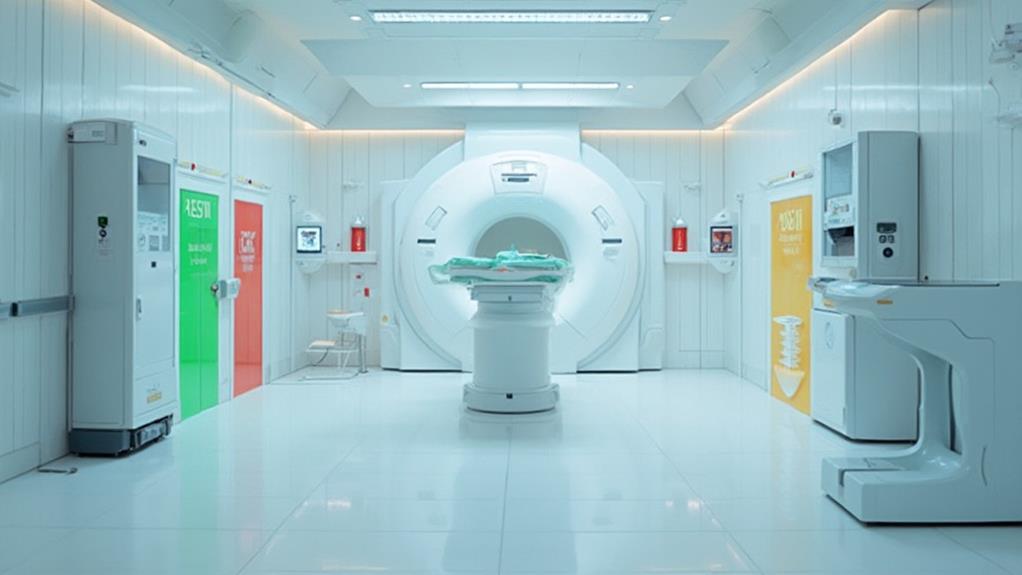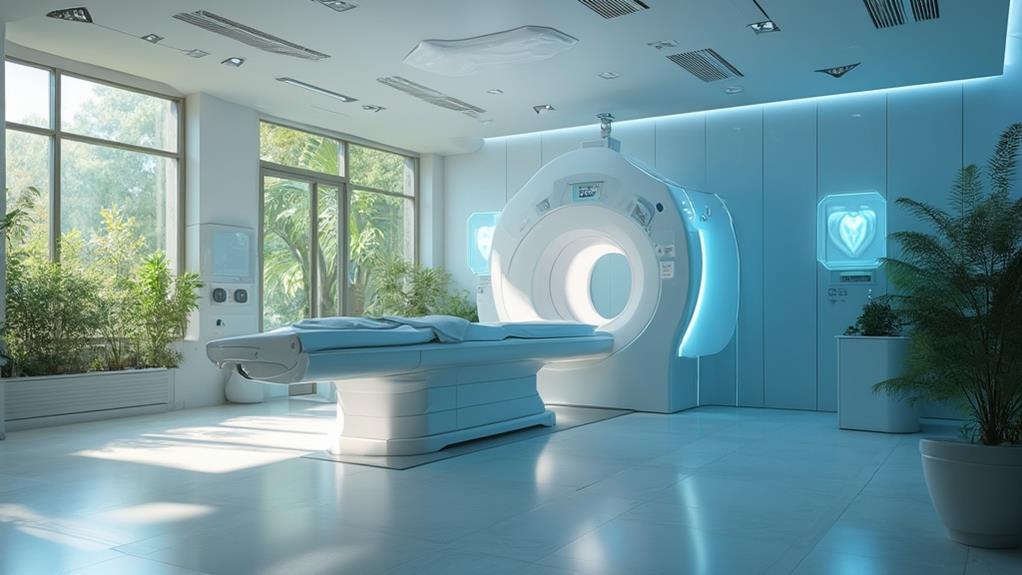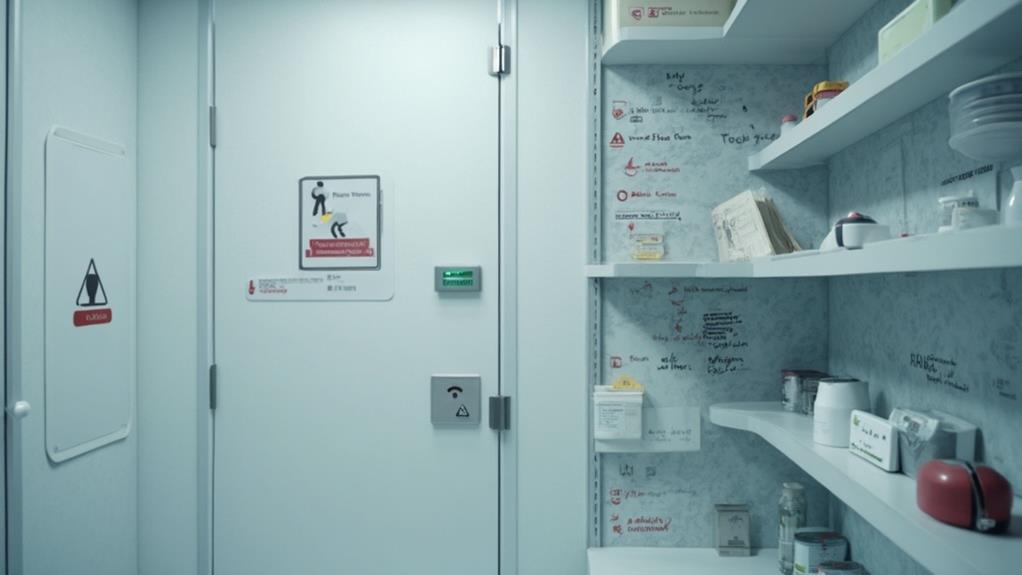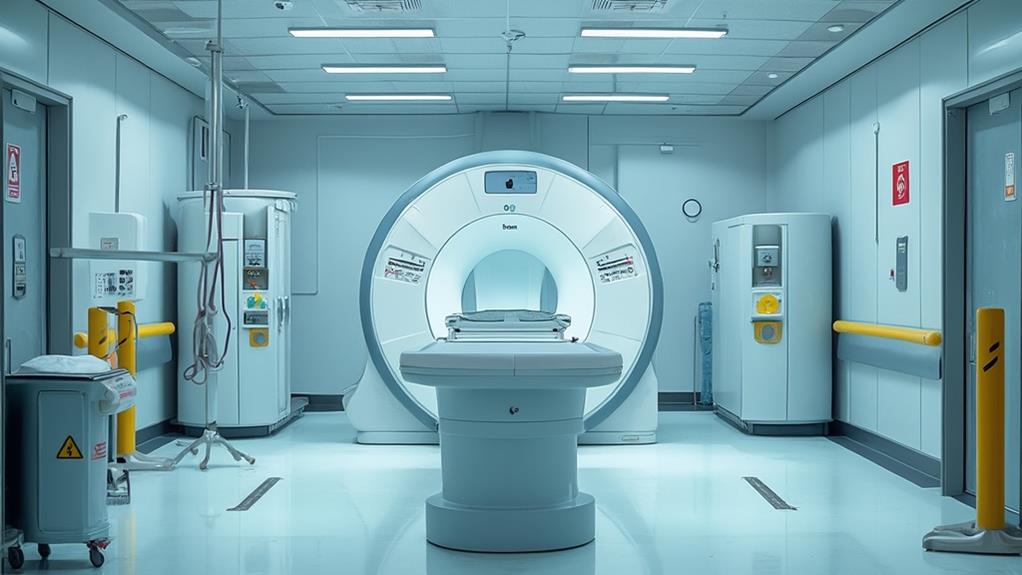MRI safety guidelines are essential to minimize risks associated with powerful magnetic fields and radiofrequency energy. Proper patient screening for contraindications, such as metallic implants, is indispensable. Patients must remove metal objects before scanning to avoid projectiles and tissue heating. Healthcare providers should secure ideal patient positioning and explain the procedure to guarantee comfort and cooperation. Providing ear protection against noise and administering sedation when necessary are also critical measures. Continuous monitoring and communication during the scan enhance safety and allow for immediate intervention. Adhering to these guidelines confirms a safe and effective MRI experience, thereby addressing any further concerns or requirements.
MRI Highlights
- Continuously screen patients for contraindications to minimize risks.
- Ensure removal of all metallic objects before the MRI scan.
- Secure correct patient positioning for injury prevention and clear imaging.
- Provide earplugs or headphones to reduce noise-related distress.
- Maintain open communication and continuous patient monitoring during the scan.
Definition of MRI Safety

MRI safety is paramount due to the powerful magnetic fields involved, which can pose significant risks, particularly with metal objects that may become projectiles.
It is also essential to adhere to MRI examination process guidelines, such as screening for possible risks and ensuring patient comfort during the scan. Additionally, ensuring the correct positioning of patients is vital to avoiding injuries and guaranteeing clear imaging results.
These considerations are essential for maintaining the highest standards of safety and efficacy during MRI procedures.
Importance of Safety
Safeguarding safety in the magnetic resonance imaging (MRI) environment is paramount due to the powerful magnetic fields and radiofrequency energy involved. Such fields pose potential risks, including the attraction of ferromagnetic objects and inadvertent heating of body tissues. Consequently, comprehending and adhering to stringent MRI safety guidelines is essential for protecting patients, healthcare providers, and facility staff.
Professionals committed to serving others must prioritize a thorough understanding of MRI safety. This involves not only recognizing the inherent dangers but also implementing system-wide protocols to mitigate potential hazards. Training and education in MRI safety enable healthcare practitioners to identify risks early and respond appropriately. In turn, this guarantees smoother, safer imaging procedures and minimizes the likelihood of adverse incidents.
Furthermore, the rigor of adhering to MRI safety guidelines extends beyond direct patient care. It encompasses maintaining and periodically updating safety equipment and procedures within the MRI suite. This ongoing vigilance guarantees that emerging technologies and new findings are incorporated into daily practices.
Metal Object Risks
Metal objects within the MRI environment pose notable risks due to the intense magnetic fields generated by the equipment. These potent magnetic fields can interact with metallic items in various ways, leading to potential hazards for both patients and healthcare professionals. Understanding these risks is essential to ensuring a safe MRI experience.
First, projectile risk is a primary concern. Metal objects can be swiftly drawn toward the MRI scanner, causing serious injury or equipment damage. The force exerted by the magnetic field can turn even small objects into high-speed projectiles.
Second, thermal injuries can occur. Metals within the MRI scanner can heat up substantially due to radiofrequency pulses. This can cause burns or other thermal injuries to patients or staff, especially if the metal is in direct contact with the skin.
Third, image distortion is another noteworthy issue. Metallic objects can interfere with the magnetic field and distort the MRI images, impacting diagnostic accuracy. This can lead to misdiagnoses or the need for repeated scans, hindering patient care.
Safe Positioning Techniques
Proper positioning of patients and staff is critical to maintaining a safe environment during MRI procedures. Ensuring the correct alignment and placement mitigates risks associated with the strong magnetic fields used in MRI technology. Careful consideration must be given to eliminate any potential hazards before scanning begins. This includes confirming that all patients are free from metallic objects, as these can become dangerous projectiles or cause burns due to radiofrequency energy.
Patients should be properly situated on the MRI table, usually in a supine position, while ensuring comfort and maintaining immobility to reduce motion artifacts in the images. Personnel should double-check placements, particularly for monitoring or support devices to prevent displacement or malfunction. Soft pads and cushions can be utilized to minimize discomfort and involuntary movements during prolonged examinations.
Equally important is the staff’s positioning during the MRI process. Technologists should remain within safe zones and avoid entering the scanner room unless absolutely necessary. Clear communication with patients is crucial, ensuring they are informed about what to expect during the procedure, consequently reducing anxiety-induced movements. By adhering to these positioning techniques, MRI procedures can be conducted efficiently, prioritizing safety and patient care.
Benefits

The utilization of MRI technology offers numerous benefits, including enhanced imaging quality, which aids in accurate diagnosis. With the use of contrast agents, the visibility of internal structures is substantially improved.
This non-invasive procedure contributes to patient comfort while enabling early detection of various diseases. Consequently, MRI serves as a critical tool in modern healthcare, facilitating effective medical interventions.
Enhanced Imaging Quality
Elevating the quality of medical imaging has become a cornerstone in advancing diagnostic accuracy and patient care. Magnetic Resonance Imaging (MRI) is pivotal in this domain, offering unparalleled benefits in producing high-resolution images that profoundly enhance clinical evaluations.
Enhanced imaging quality provides several pivotal advantages:
- Superior Detail Resolution: MRI’s advanced technology yields images with exceptional detail, offering glimpses into minute anatomical structures. This resolution is indispensable for identifying subtle abnormalities that might be missed by other imaging techniques.
- Non-Invasive Precision: Unlike certain methodologies requiring invasive procedures, MRI can achieve precise visualizations non-invasively. This facet not only reduces patient discomfort but also minimizes the risks associated with invasive diagnostic tools.
- Advanced Soft Tissue Contrast: MRI excels in differentiating between various soft tissues. This proficiency is particularly essential in diagnosing conditions related to the brain, spinal cord, and musculoskeletal system, where clear differentiation is indispensable.
The high-quality imaging provided by MRI underscores its essential role in modern medicine. By harnessing these capabilities, healthcare professionals can deliver more effective and personalized care, ultimately improving patient outcomes. Through continuous innovation and adherence to safety protocols, the medical community can guarantee that MRI technology remains a reliable cornerstone in diagnostic medicine.
Accurate Diagnosis Assistance
Accurate diagnosis is the cornerstone of effective medical treatment, and MRI technology drastically enhances this capability. Magnetic Resonance Imaging (MRI) is pivotal in identifying a myriad of health issues with remarkable precision. This detailed imagery enables healthcare providers to pinpoint abnormalities, such as tumors, brain disorders, and spinal cord injuries, with exceptional accuracy, facilitating timely and appropriate interventions.
The specificity of MRI allows clinicians to distinguish between different types of tissues, which is essential for detecting diseases in their early stages. For instance, MRI can effectively differentiate between benign and malignant tumors, enhancing the quality of patient care. In addition, this technology is instrumental in monitoring the progression of chronic conditions, enabling personalized and adaptive treatment plans that are indispensable for long-term health management.
Moreover, MRI assists in planning surgical procedures by providing a thorough map of the body’s internal structures. This reduces the risk of complications and improves the outcomes of surgeries. The high-resolution images produced by MRI scans offer unparalleled detail, ensuring that clinicians can make well-informed decisions. Consequently, the utilization of MRI technology is indispensable in ensuring accurate diagnoses, ultimately enhancing patient outcomes and contributing significantly to the success of medical interventions.
Non-invasive Procedure Benefits
Among the numerous advantages of MRI technology, its non-invasive nature stands out prominently. This feature is particularly appealing in the medical field, offering significant benefits to both patients and healthcare providers.
One key benefit is the reduced physical discomfort for patients. Since MRI does not involve incisions or the introduction of instruments into the body, patients can undergo the procedure without experiencing pain associated with invasive techniques. This increases patient compliance and comfort, contributing to a more positive healthcare experience.
Second, the non-invasive nature of MRI means there is a lower risk of complications. Traditional diagnostic methods sometimes carry the threat of infection or adverse reactions. In contrast, MRI employs powerful magnetic fields and radio waves to generate detailed images, virtually eliminating these risks.
Finally, MRI allows for extensive, precise imaging without exposure to ionizing radiation. Unlike X-rays or CT scans, which can place patients at risk for radiation-related issues, MRI is a safer option. This is particularly beneficial for individuals who require multiple imaging sessions, including pediatric or chronically ill patients.
Overall, the non-invasive benefits of MRI technology help improve patient care while minimizing risk, making it an indispensable tool in modern medical practice.
- Reduced physical discomfort
- Lower risk of complications
- No ionizing radiation exposure
Early Disease Detection
Early disease detection is a critical advantage offered by MRI technology, profoundly enhancing the prognosis and management of various medical conditions. MRI scans provide highly detailed images of soft tissues, organs, and other internal structures, enabling practitioners to identify abnormalities at their earliest stages. This early detection is particularly vital in diagnosing conditions such as cancer, cardiovascular diseases, neurological disorders, and musculoskeletal injuries. By catching these issues early, medical professionals can develop more effective treatment plans and improve patient outcomes drastically.
Moreover, MRI’s ability to detect subtle changes in tissue composition and structure allows for more precise monitoring of disease progression. This is invaluable for conditions that require ongoing surveillance, such as multiple sclerosis and certain types of cancer. The high-resolution images produced by MRI can reveal even the smallest lesions or growths that might be missed with other imaging modalities.
Additionally, early detection facilitated by MRI can reduce the need for more invasive diagnostic procedures, which may carry higher risks and discomfort for patients. This not only enhances patient comfort but also promotes well-being by minimizing unnecessary interventions. Ultimately, the use of MRI for early disease detection aligns with the overarching goal of providing timely and effective patient care.
Common MRI Safety Risks

MRI procedures, while indispensable for diagnostic imaging, involve several safety risks that must be carefully managed. These risks include metal object hazards, claustrophobia and anxiety experienced by some patients, and noise levels that necessitate hearing protection. The following table outlines these common safety risks:
| Safety Risk | Details |
|---|---|
| Metal Object Hazards | Potential for metal objects to become projectiles |
| Claustrophobia and Anxiety | Discomfort due to confined space |
| Noise and Hearing Protection | High decibel levels during scanning |
Metal Object Hazards
In the context of MRI safety, one of the most critical risks to address is the presence of metal objects. The strong magnetic fields generated during an MRI scan can pose significant hazards if certain precautions are not adhered to. Metal objects can become projectile within the MRI environment, leading to severe injuries or equipment damage. They may also cause image artifacts that can compromise the diagnostic quality of the MRI scan.
To guarantee the safety of patients and healthcare providers, it is indispensable to be aware of the following metal object hazards:
- Metallic Implants and Devices: Items such as pacemakers, aneurysm clips, and certain cochlear implants can malfunction or move, posing a risk to the patient’s health.
- External Metallic Objects: Everyday items like jewelry, hairpins, and eyeglasses must be removed before entering the MRI room to prevent them from becoming dangerous projectiles.
- Ferromagnetic Equipment: Tools and carts used by healthcare staff should be MRI-compatible to avoid attraction by the MRI’s powerful magnet.
Thorough screening for metal objects and rigorous adherence to MRI safety protocols are essential in creating a safe and effective examination environment.
Claustrophobia and Anxiety
Addressing another considerable aspect of MRI safety, dealing with patient claustrophobia and anxiety is paramount to ensuring a successful procedure. MRI machines are enclosed spaces that can trigger feelings of discomfort and panic in patients prone to claustrophobia. This psychological response can result in interrupted scans, non-conclusive results, or even termination of the procedure, thereby compromising the effectiveness of the MRI.
To mitigate these risks, healthcare providers should adopt a proactive approach. Communicating clearly about the procedure, duration, and what to expect can alleviate some patient fears. Offering pre-scan tours of the MRI suite can desensitize patients to the environment.
Additionally, employing relaxation techniques such as deep breathing exercises or providing calming music can ease anxiety. Sedation is another viable option for those with severe claustrophobia; however, this entails additional considerations and pre-procedure coordination. Open MRI machines, which offer a less confined space, can also be a solution for particularly anxious individuals.
The incorporation of these strategies not only enhances patient comfort but greatly contributes to the overall success of the procedure, reflecting a commitment to patient-centered care. Hence, addressing claustrophobia and anxiety is fundamental in optimizing MRI safety and effectiveness.
Noise and Hearing Protection
One notable safety consideration during an MRI procedure is the considerable noise generated by the machine. The rapid switching of magnetic gradients produces loud knocking and tapping sounds that can reach up to 120 decibels, comparable to the volume of a rock concert. This intensity of noise poses a risk to patients’ hearing and can lead to discomfort or even hearing damage if not properly managed.
To mitigate these risks and guarantee patient comfort, healthcare providers should adhere to the following guidelines:
- Provision of Ear Protection: All patients undergoing MRI scans should be given earplugs or noise-canceling headphones. These devices help tremendously reduce the impact of the loud noise generated during the scanning process.
- Explanation and Assurance: Before the procedure, practitioners should explain the noise levels to patients and reassure them that the sounds are normal. This can help reduce anxiety and prepare patients for the experience.
- Monitoring and Communication: Continuous monitoring of patients during the scan, as well as maintaining open lines of communication through intercom systems, enables immediate intervention if the patient experiences distress due to noise or other factors.
Adopting these measures will enhance patient safety and comfort during MRI procedures.
MRI FAQ
What Should I Wear for My MRI Appointment?
For your MRI appointment, it is recommended to wear loose, comfortable clothing without any metal components. Avoid accessories such as jewelry, watches, or hairpins to facilitate a smooth and safe imaging process.
Can I Listen to Music During the MRI Scan?
Yes, you may listen to music during the MRI scan. Many facilities offer headphones or earplugs to help keep patients calm and comfortable. You can request this service when scheduling your appointment for ideal relaxation.
Are There Specific Dietary Restrictions Before Undergoing an MRI?
Yes, some MRI procedures may require specific dietary restrictions. Typically, patients may need to fast for several hours before a scan, especially for abdominal imaging. Please follow your healthcare provider’s detailed instructions for ideal results.
Is It Safe to Have an MRI if I Have a Tattoo?
The safety of undergoing an MRI with a tattoo depends on factors such as the type of ink and tattoo age. Communicate with your healthcare provider to guarantee a safe and comfortable experience tailored to your specific circumstances.
How Long Does the MRI Procedure Typically Take?
The duration of an MRI procedure can vary but typically ranges from 30 minutes to an hour. This timeframe guarantees thorough imaging, allowing healthcare professionals to provide accurate diagnoses and deliver the best possible patient care.
